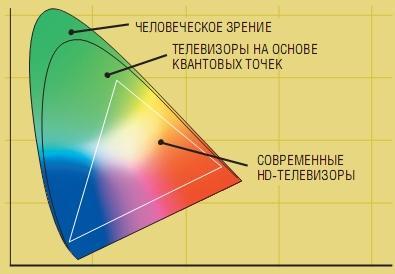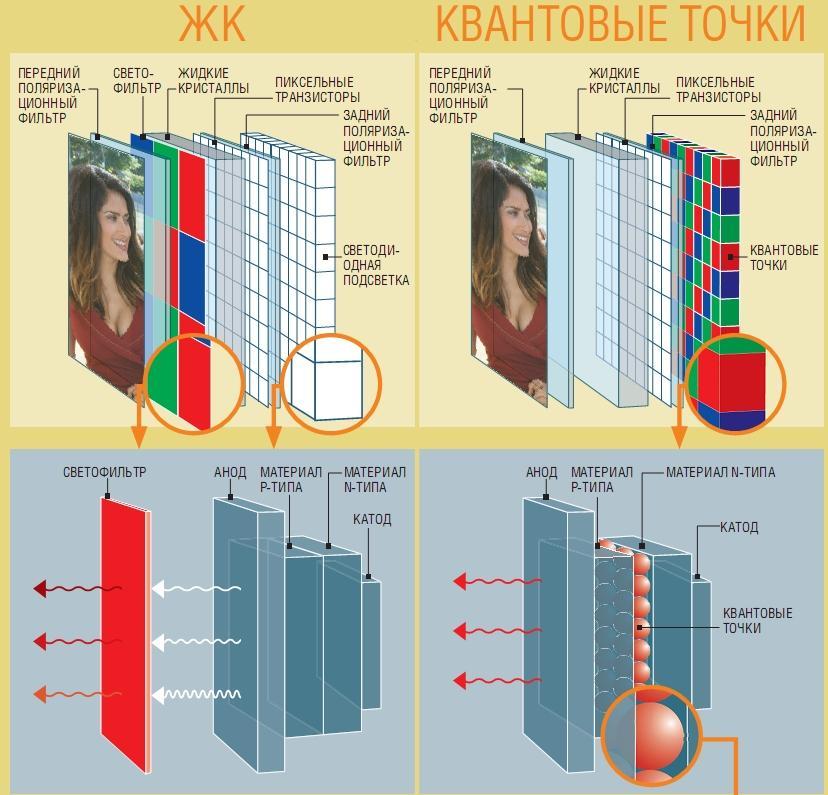Quantum dots and why they are put
Good time of the day, Habrazhiteli! I think many have noticed that more and more advertising about displays based on quantum dot technology has started to appear, so-called QD - LED (QLED) displays and despite the fact that at the moment this is just marketing. Similarly, LED TV and Retina is an LCD display technology that uses quantum dots as the backlight.
Your humble servant decided to still understand what quantum dots are and what they eat with.

A quantum dot is a fragment of a conductor or semiconductor whose charge carriers (electrons or holes) are limited in space in all three dimensions. The size of the quantum dot must be so small that the quantum effects are significant. This is achieved if the kinetic energy of an electron is noticeably greater than all other energy scales: first of all, it is greater than the temperature, expressed in energy units. Quantum dots were first synthesized in the early 1980s by Alexei Ekimov in a glass matrix and Louis E. Bruce in colloidal solutions. The term "quantum dot" was proposed by Mark Reed.
')
The energy spectrum of the quantum dot is discrete, and the distance between the stationary energy levels of the charge carrier depends on the size of the quantum dot itself as - ħ / (2md ^ 2), where:
In simple terms, a quantum dot is a semiconductor whose electrical characteristics depend on its size and shape.

For example, when an electron moves to a lower energy level, a photon is emitted; since it is possible to adjust the size of a quantum dot, it is also possible to change the energy of the emitted photon, and therefore change the color of the emitted quantum dot of light.
There are two types:
In fact, they are named after the methods of their receipt. I will not talk about them in detail due to the large number of chemical terms(Google help) . I will add only that with the help of colloid synthesis it is possible to obtain nanocrystals coated with a layer of adsorbed surface-active molecules. Thus, they are soluble in organic solvents, after modification - also in polar solvents.
Usually a quantum dot is a semiconductor crystal in which quantum effects are realized. An electron in such a crystal feels like a three-dimensional potential well and has many stationary energy levels. Accordingly, when moving from one level to another, a quantum dot can emit a photon. With all this, the transitions are easy to control by changing the size of the crystal. It is also possible to transfer the electron to a high energy level and receive radiation from the transition between lower-lying levels and as a result we obtain luminescence. Actually, it was the observation of this phenomenon that served as the first observation of quantum dots.
The history of full-fledged displays began in February 2011, when Samsung Electronics presented the development of a full-color display based on QLED quantum dots. It was a 4-inch display driven by an active matrix, i.e. each color pixel with a quantum dot can be turned on and off with a thin-film transistor.
To create a prototype, a layer of a solution of quantum dots is applied to the silicon board and the solvent is sprayed. After that, a rubber stamp with a comb surface is pressed into the layer of quantum dots, separated and stamped onto glass or flexible plastic. This is how the strips of quantum dots are applied to the substrate. In color displays, each pixel contains a red, green, or blue subpixel. Accordingly, these colors are used with different intensities to obtain as many shades as possible.
The next step in the development was the publication of the article by scientists from the Indian Institute of Science in Bangalore. Where quantum dots have been described that luminesce not only in orange, but also in the range from dark green to red.
The main difference between the QLED-display and the LCD is that the latter are able to cover only 20-30% of the color range. Also, in QLED TVs, there is no need to use a layer with light filters, since crystals, when voltage is applied to them, always emit light with a well-defined wavelength and, as a result, with the same color value.

There were also news about the sale of a computer display on quantum dots in China. Unfortunately, to personally check, in contrast to the TV, I have not had a chance.
PS It should be noted that the scope of quantum dots is not limited to LED - monitors, among other things, they can be used in field-effect transistors, photo cells, laser diodes, they are also being studied for their use in medicine and quantum computing.
PPS If we talk about my personal opinion, I believe that they will not be popular for the next ten years, not because they are little known, but because the prices of these displays are transcendental, but still I would like to hope that quantum dots will find their application in medicine, and will be used not only to increase profits, but also for good purposes.
Your humble servant decided to still understand what quantum dots are and what they eat with.

Instead of introducing
A quantum dot is a fragment of a conductor or semiconductor whose charge carriers (electrons or holes) are limited in space in all three dimensions. The size of the quantum dot must be so small that the quantum effects are significant. This is achieved if the kinetic energy of an electron is noticeably greater than all other energy scales: first of all, it is greater than the temperature, expressed in energy units. Quantum dots were first synthesized in the early 1980s by Alexei Ekimov in a glass matrix and Louis E. Bruce in colloidal solutions. The term "quantum dot" was proposed by Mark Reed.
')
The energy spectrum of the quantum dot is discrete, and the distance between the stationary energy levels of the charge carrier depends on the size of the quantum dot itself as - ħ / (2md ^ 2), where:
- ħ is the reduced Planck constant;
- d is the characteristic point size;
- m is the effective electron mass at a point
In simple terms, a quantum dot is a semiconductor whose electrical characteristics depend on its size and shape.

For example, when an electron moves to a lower energy level, a photon is emitted; since it is possible to adjust the size of a quantum dot, it is also possible to change the energy of the emitted photon, and therefore change the color of the emitted quantum dot of light.
Types of quantum dots
There are two types:
- epitaxial quantum dots;
- colloidal quantum dots.
In fact, they are named after the methods of their receipt. I will not talk about them in detail due to the large number of chemical terms
Quantum dot construction
Usually a quantum dot is a semiconductor crystal in which quantum effects are realized. An electron in such a crystal feels like a three-dimensional potential well and has many stationary energy levels. Accordingly, when moving from one level to another, a quantum dot can emit a photon. With all this, the transitions are easy to control by changing the size of the crystal. It is also possible to transfer the electron to a high energy level and receive radiation from the transition between lower-lying levels and as a result we obtain luminescence. Actually, it was the observation of this phenomenon that served as the first observation of quantum dots.
Now about the displays
The history of full-fledged displays began in February 2011, when Samsung Electronics presented the development of a full-color display based on QLED quantum dots. It was a 4-inch display driven by an active matrix, i.e. each color pixel with a quantum dot can be turned on and off with a thin-film transistor.
To create a prototype, a layer of a solution of quantum dots is applied to the silicon board and the solvent is sprayed. After that, a rubber stamp with a comb surface is pressed into the layer of quantum dots, separated and stamped onto glass or flexible plastic. This is how the strips of quantum dots are applied to the substrate. In color displays, each pixel contains a red, green, or blue subpixel. Accordingly, these colors are used with different intensities to obtain as many shades as possible.
The next step in the development was the publication of the article by scientists from the Indian Institute of Science in Bangalore. Where quantum dots have been described that luminesce not only in orange, but also in the range from dark green to red.
What is worse LCD?
The main difference between the QLED-display and the LCD is that the latter are able to cover only 20-30% of the color range. Also, in QLED TVs, there is no need to use a layer with light filters, since crystals, when voltage is applied to them, always emit light with a well-defined wavelength and, as a result, with the same color value.

There were also news about the sale of a computer display on quantum dots in China. Unfortunately, to personally check, in contrast to the TV, I have not had a chance.
PS It should be noted that the scope of quantum dots is not limited to LED - monitors, among other things, they can be used in field-effect transistors, photo cells, laser diodes, they are also being studied for their use in medicine and quantum computing.
PPS If we talk about my personal opinion, I believe that they will not be popular for the next ten years, not because they are little known, but because the prices of these displays are transcendental, but still I would like to hope that quantum dots will find their application in medicine, and will be used not only to increase profits, but also for good purposes.
Source: https://habr.com/ru/post/316810/
All Articles